Bivingsville and Glendale
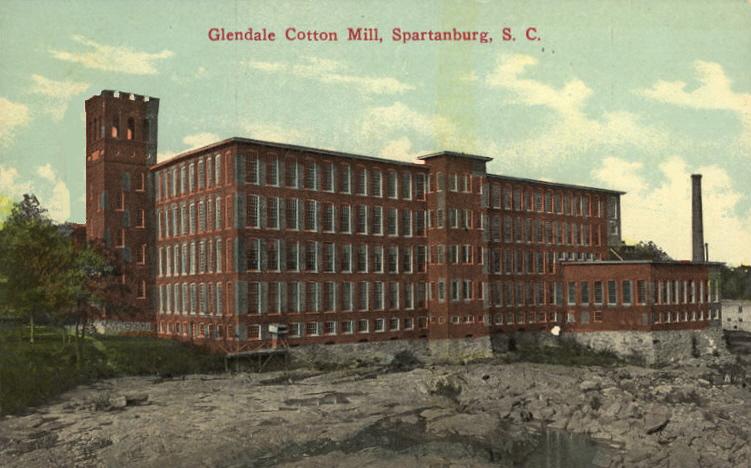
(Mill shown about 1910).
Period 1830 - 1860

(Mill shown about 1910).
The first large textile mill in the Spartanburg area was that which came to be called the Bivingsville Cotton Factory. All of the mills which preceded it were small and meagerly equipped. Its erection may, then, be regarded as a milestone in the history in the textile history of Spartanburg - and indeed of the state because textile operations have gone on at the same place uninterruptedly until 1961.
Steps toward building Bivingsville began in the early 1830’s, under the leadership of Dr. James Bivings, who came from Lincolnton, North Carolina, about 1832. He brought with him a full set of competent workmen, stonemasons, carpenters, machinists, and the factory building that he put up was, for its time, a very imposing affair. He bought his machinery in Patterson, New Jersey. One feature which elicited admiration was an overshot water wheel which was 26 feet in diameter and 12 foot wide. This mill had 1,200 spindles and 24 looms.
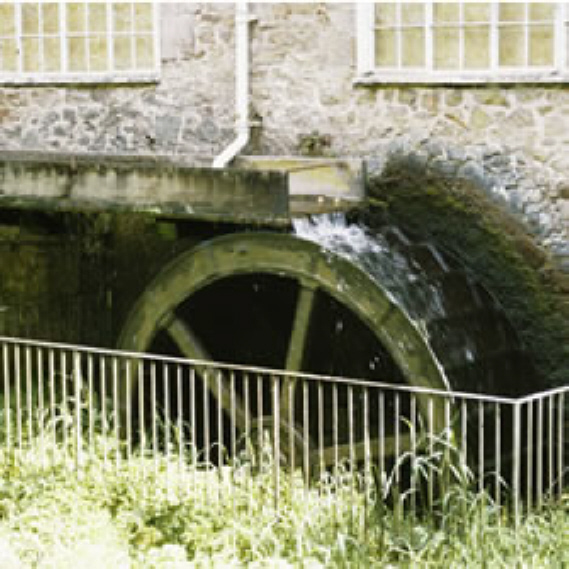
(Similar Waterwheel but not at Glendale.)
Mr. Jim Brooks has found some very interesting newspaper advertising relating to the early Bivingsville mill in his research about Glendale history. The advertisements are from the Greenville Mountaineer Newspaper of 1837. One advertisement from April, 1837 is solicting bricks and brick masons and other workers for constructing the mill. The second ad from July, 1837 is announcing that the mill is in operation and now producing yarn. Both ads can be read in detail at 1837 Newspaper Advertisements.
County records show that Dr. Bivings acquired titles to extensive tracts of land adjacent to and including the site of Wofford’s Iron Works. He organized a company named the Bivingsville Cotton Manufacturing Company with the stated purpose of manufacturing cotton and wool. The owners and investors in the company were James Bivings, Simpson Bobo and Elias C. Leitner. The original starting capitol was $100,000 with the privilege of increasing to $500,000. The company had not been long in operation when a dispute and a lawsuit arose which ultimately resulted in the departure of Dr. Bivings from the mill company to which he had given his name with pride. However, the town continued to be known as Bivingsville until 1878 when it was changed to the present name of Glendale.
In 1847, Bivingsville Mill was listed as one of the important cotton mills of the state. By this time the mill was owned by G. and E.C. Leitner. In 1856, the company fell on hard times financially and was sold in bankruptcy proceedings. The company and mill was bought by a group of local investors that included Dexter E. Converse. Converse was named as manager of the mill. He was already living in the Bivingsville. He had moved into the former home of Dr. Bivings in February of 1855. The mill was still in operation as it weathered the financial problems and change of owners.
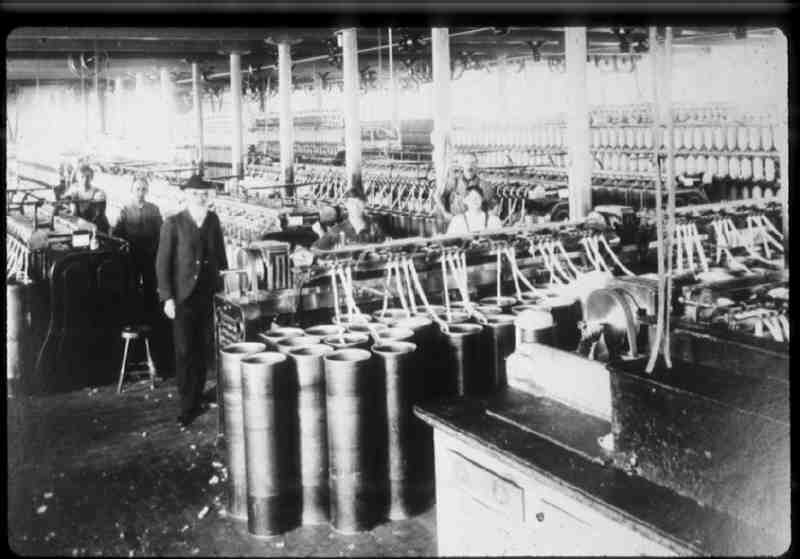
Period 1860 - 1900(Textile mill workers - not at Glendale)
During the Civil War, the mill made cloth and other products for the Confederacy. This included a quantity of wooden shoe soles. After the War, Converse, along with his brother-in-law, Albert Twitchell, became the owners of the mill and the property. By 1875, 10 years after the War, the mill had 5,000 spindles and 120 looms. The mill village had 60 houses with 400 residents. It also had a sawmill, two cotton gins, a machine shop and a carpenter shop.
After the War, many other textile mills were built in the Upstate. The mill at Glendale flourished and expanded in the 1880’s and 1890’s. It came to have 17,280 spindles and 518 looms. The mill building itself was enlarged by a three story addition. During this time, the number of houses in the village for the workers increased to 75 homes.
In 1899, Dexter Converse died after a long association with the Glendale Mill. He was followed as company president by his brother-in-law Albert Twitchell. The mill continued to prosper after the turn of the century. By 1900, the town had a school with 125 students and one teacher. Finding workers for the mill became an increasing problem around this time and workers were recruited from further and further away, even from the mountains of North Carolina. The ancestors of many of Glendale’s long term residents came around this time.
See an analyses of the Census for Bivingsville in 1860 at 1860 Census and the 1900 Census at 1900 Census.
The factories at Bivingsville were very important not only to the folks that worked there but to the farmers and other people who lived in the Spartanburg vicinity. This is shown in a journal kept over a 15 year period by David G. Harris around the time of the Civil War. He was a farmer who lived near the Pauline community, over eight miles from Bivingsville. Click on the above link to read more about this.
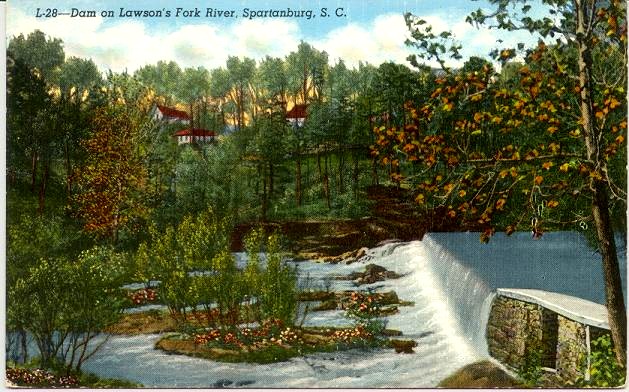
Period 1900- 1945(Old Post Card showing dam across Lawson's Fork Creek. It is not known exactly where this was located but is thought not to be at Glendale.)
World War I brought increased work for Glendale and the other textile mills of the Piedmont. The War also affected some of the young men of the community and a number of them were in service. As a result of the War, a large training camp was built in Spartanburg. It was called Camp Wadsworth and was located in the area that Westgate Mall is today. Building the camp provided work for many people in Spartanburg, including a number of men from Glendale. Some of the recruits from Camp Wadsworth eventually came to the Glendale community to visit with the residents there.
See an analyses of the Glendale Census in 1920 at 1920 Census. See a map for the 1940 census at 1940 Map.
The mill continued on under the same ownership through the 1920’s and 1930’s. The Great Depression hit the Upstate textile industry hard. Several banks in the county closed. Hundreds of textile workers throughout the state lost their jobs. Glendale, like all the other mills, saw hard times. The work was curtailed and the number of workdays a week was cut way back. Sometimes the mill was opened two or three days a week. Many of the mills were no longer able to pay their workers with cash but issued “script”. This “script” could be spent at the company stores for groceries and other essentials. The textile industry did not really recover from the effects of the depression until World War II.
World War II brought a boom to the textile industry, including Glendale. The mills ran three shifts to meet the demand for cloth. Many of Glendale’s young men were affected. Many volunteered for the various branches of the armed forces and others were drafted. As in World War I, a new training camp came to the Spartanburg area. This one, Camp Croft, was very close to Glendale. Building the camp provided many jobs for the local people. The camp was built in an amazingly short time and was filled with recruits. A number of these recruits would eventually marry local girls and some would come back to settle in the area.
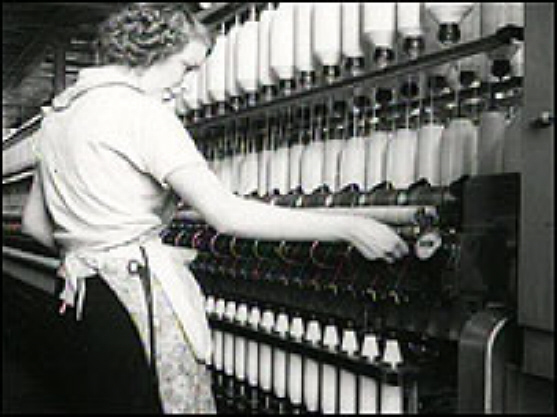
(Worker in a mill - not at Glendale)
Period 1945 - Present
After the War, a period of change came to Glendale that is still in process. In 1946, the Converse Company that had operated the mill since 1856, a period of 80 years, sold it. The new owners were the J.L. Stifel and Sons of Wheeling West Virginia. The Stifel Company made major renovations to the mill. They converted the mill from steam power to electrically powered operations. The company remodeled many of the company houses and tore down about 35 houses that were in bad condition. At some time in the past, additional houses had been built. Present day maps show about 120 houses in the mill village. In the 1950’s, the company began to sell the houses to the workers. Over a period of time, the mill company owned less and less of the village. By 1956, the company had more 600 employees. It was a big source of employment for the county.
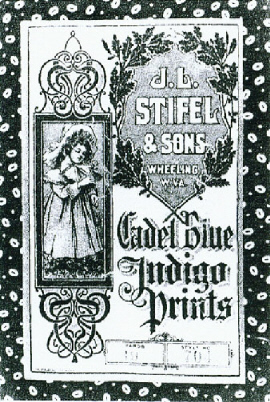
However, in 1957, Stifel and Sons sold the mill to Indian Head Mills. This was the beginning of the end for textile manufacturing in Glendale. Indian Head Mills stopped manufacturing in the mill in November of 1961.
All of the mill land and assets were eventualy sold or given away. Read about this and the deed transfers involved at Sale of Mill Assets.
There were several small attempts to use the facilities for making textiles. They were all short lived. The glory days of the Glendale textile operations were gone forever. This same story was repeated all over the Upstate of South Carolina and indeed all over the South. In a period of about 25 years, the Upstate textile industry was destroyed. It was sent overseas to be done by cheap foreign labor. The loss of the mills not only destroyed the textile industry, it brought major damage to an entire generation of textile workers. Many have never recovered. Read about the passing generations and their connection to the mill.
With the new day, there came new plans as to what to do with the old mill structure itself. The end of all these plans came to a terrible end on Sunday, March 21, 2004. On this day, the mill caught on fire and was completely burned down.

Life Goes On
A view of the shoals, dam and old iron bridge today. (Photo by Jim Cody)
These wildflowers bloom not far from the burned ruins of the mill. (Photo by Jim Cody)
(The above account of the textile industry at Glendale is based on material from:
A History of Spartanburg County - by WPA
Glendale - A Pictorial History by M. Hembree and Paul Crocker
Spartanburg - Facts, Reminiscences, Folklore by Vernon Foster)
Mr. Clarence Crocker, a life long Glendale resident and a Supervisor in the mill, has furnished us a detailed, more personal account of the story of Bivingsville and Glendale Mills. It is accompanied by numerous photographs. Click on Mill Story to see this.
Mr. Crocker also furnished a photographic record of how cotton was made into cloth at Glendale. See this at Cloth Making.
This web site has been started as a public service to share the story of Glendale. See more information about Mary and her Glendale connection at Mary McKinney Teaster.